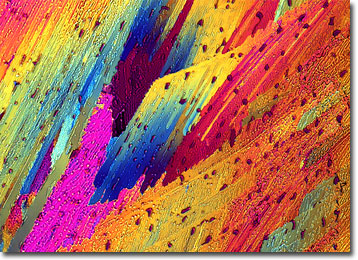Polarized Light Microscopy Digital Image Gallery
Lycopene
Lycopene is a carotenoid originally isolated from a type of European yam in 1873. The proven antioxidant is best known, however, as a constituent of tomatoes, from which it was first extracted in 1875.

Similar to other carotenoids, lycopene is responsible for the coloration of various fruits and vegetables. Lycopene provides, for instance, the red pigment of tomatoes and certain varieties of chilies, as well as the pinkish hue of watermelon, grapefruit, and guava. As a carotenoid, lycopene is also essential for plant growth and photosynthesis. The substance, which can only be manufactured by green plants and some microorganisms, is also being found to be important for the good health of humans and other animals, which must obtain lycopene through dietary sources.
Lycopene tends to concentrate in bodily tissues at higher amounts than all other carotenoids, especially in the testes and adrenal glands. Indeed, dietary consumption of lycopene may be especially beneficial to men, since the carotenoid has been strongly associated with a lowered risk of prostate cancer. Some studies have also suggested that men who eat significant quantities of foods rich in lycopene are less likely to experience heart disease than those who do not. Yet, women may considerably benefit from lycopene consumption as well, since recent research indicates that lycopene may lessen the risk of macular degenerative disease, serum lipid oxidation, and cancers of the lung, bladder, cervix, and skin.
